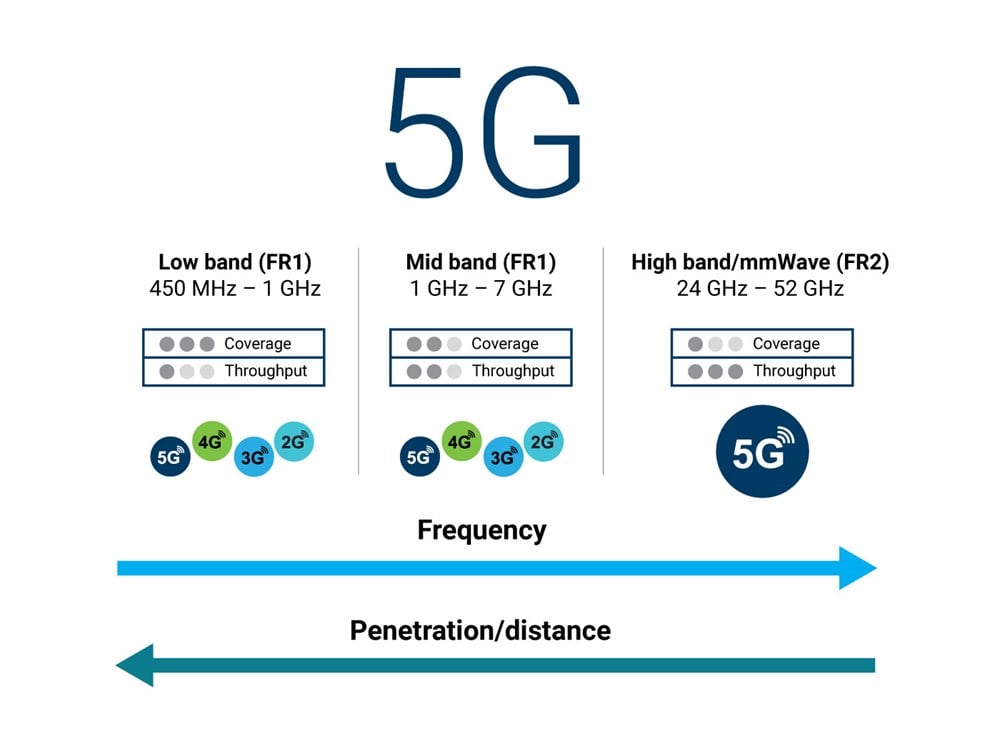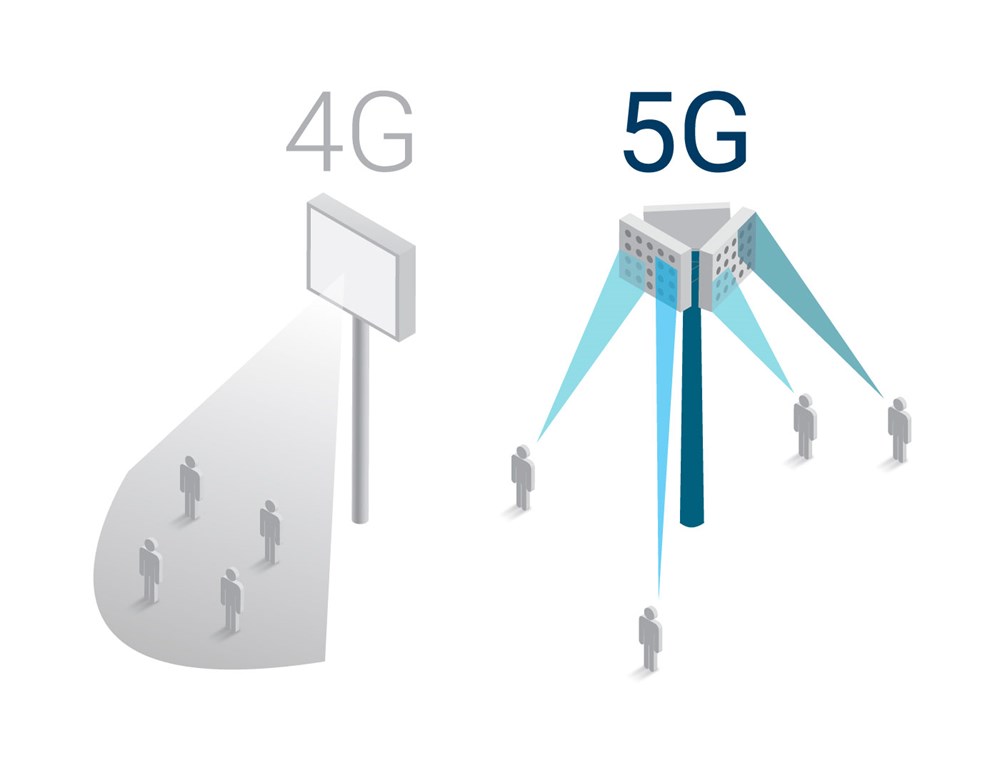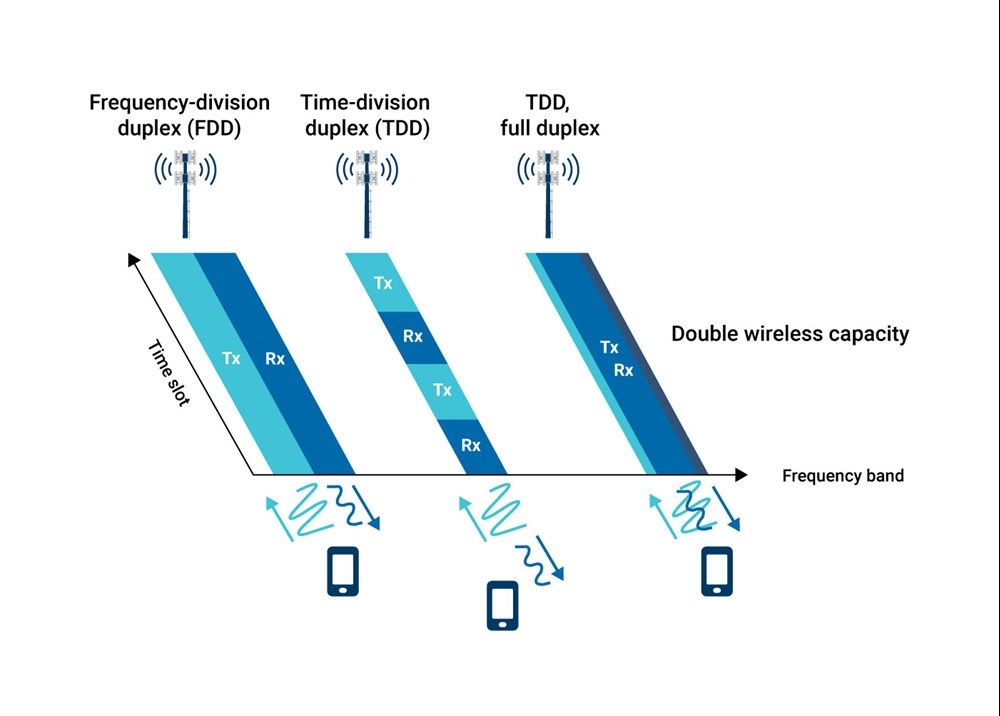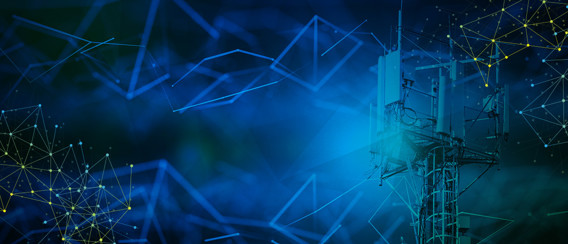RF and 5G new radio: top 5 questions answered
5G is pushing the boundaries of wireless communications, enabling use cases that rely on ultra-fast speeds, exceptionally low latency and incredibly high reliability. To support the launch of 5G, 3GPP has developed a new radio access technology called 5G new radio (NR), designed to become the standard for 5G networks worldwide. In this blog we answer the top five questions about the relationship between RF and 5G NR.
1. Which RF frequency bands are used by 5G and how does that compare to 4G?
The goal of 5G technologies extends farther than just serving mobile broadband and offers key advancements that enable a much wider range of applications. Additional 5G frequency bands are being made available to support these applications (see Figure 1). 5G NR includes several low and mid-frequency bands in the sub-7 GHz range, defined as FR1, as well as higher frequency bands above 24 GHz, defined as FR2/mmWave. 5G frequency includes all previous cellular spectrum and additional spectrum in the sub-7 GHz frequency range and beyond. A key reason that additional spectrum is being made available is to address the overcrowding in sub-7 GHz bands (see Figure 1)—and to overcome the physical limitations associated with throughput and bandwidth. For example, 4G bands accounted for up to 20 MHz of bandwidth whereas 5G bands now allow up to 400 MHz of bandwidth per channel.

Figure 1. Frequency spectrum bands and bandwidth availability.
2. What challenges come along with mmWave?
The term millimeter wave (mmWave) refers to a specific part of radio frequency (RF) spectrum with very short wavelengths (i.e., from 24.25 GHz to 52.6 GHz, as specified by 5G 3GPP). The use of mmWave will greatly increase the amount of 5G bandwidth available since this spectrum was mostly unused until now. Another advantage of mmWave is that it can transfer data even faster, even though its transfer distance is shorter. Plus, mmWave bands are less crowded. In contrast, lower frequencies are more heavily congested with TV and radio signals, as well as with current 4G LTE network signals which typically sit between 700 MHz and 3,000 MHz.
However, mmWave spectrum requires strict line-of-sight between user equipment (UE) and radio antennas. Any obstacle, or passive obstruction like highway signs in front of cell sites, trees or buildings as well as moving objects such as cars, have the potential to degrade or block a 5G FR2 signal (see Figure 2).

Figure 2. 5G radio frequency spectrum.
3. How does massive MIMO (mMIMO) and beamforming reduce 5G signal degradation?
Multiple input, multiple output (MIMO) is a technology deployed throughout legacy 4G/LTE networks whereby radio transmitters are equipped with multiple antenna ports that enable multiple data streams to be transmitted simultaneously to user equipment. MIMO is used to double (2x2 MIMO) or quadruple (4x4 MIMO) throughput performance for users connected to a cell site.
Massive MIMO (mMIMO) is an extension of MIMO, increasing the number of antennas to a 64-transmit/64-receive (64T64R MIMO) configuration. This results in mobile cell sites with higher throughput and improved efficiency.
Beamforming is a subset of mMIMO and as these new technologies come into play, we often see some confusion between the two terms. Beamforming is a signal processing technique that uses the multiple antennas available with mMIMO to create a focused signal (or beam) between an antenna and specific user equipment (see Figure 3). Signals can be controlled by modifying the magnitude and phase giving the ability for the antenna to focus on specific users. This concept can be compared to a music concert where a spotlight is focused on specific performers onstage.
This advanced RF technology is key for 5G and especially for mmWAVE bands because it solves the line-of-sight problem by steering signals around objects and can even bounce signals against building walls in order to reach user equipment.

Figure 3. Beamforming signal processing technique
4. Why are 5G mid-bands key to accelerating 5G deployments?
5G can be a challenging technology to deploy, however mid-band spectrum in the 1 GHz - 7 GHz frequency range is considered ideal for 5G as it strikes the perfect balance between coverage and throughput. The 5G community finds the 3.3 GHz to 3.8 GHz mid-bands especially appealing because this will enable most countries to have a dedicated 5G band in the sub-7 GHz range.
In the United States, RF spectrum bands ranging from 3.5 GHz to 3.7 GHz are referred to as Citizens Broadband Radio Service (CBRS). The Federal Communications Commission (FCC) in the United States has designated that this CBRS spectrum be managed by the CBRS Alliance and shared among three tiers of users: incumbent access users, priority access licenses (PALs) and generally authorized access (GAA) users. Incumbent users include military and fixed satellite stations. PALs include operators who must acquire their spectrum block through spectrum auction (licensed spectrum). The GAA tier is comprised of unlicensed spectrum available for use by anyone, free of charge.
New 5G radio equipment enables Massive MIMO (mMIMO) and beamforming at 3.5 GHz. Initially, beamforming was available only within higher mmWAVE bands. Now radio equipment vendors are enabling beamforming for 5G mid-bands as well, making those bands more appealing. These new 5G mid-bands simplify rollouts and accelerate the race to 5G. Around the world, spectrum auctions are being held to acquire these new bands and mobile operators that want to take the lead in 5G deployments will need deep pockets in order to win these coveted 5G mid-bands.
5. What is TDD and why is it important for 5G?
Time Division Duplexing (TDD) is a technique to emulate full-duplex communication over a half-duplex communication link by transmitting the downlink (DL) and receiving the uplink (UL) at the same frequency but using synchronized time intervals (see Figure 4). The UL and DL are separated by a guard period to avoid overlapping of the communication channels. Due to advanced technology, the switching is done within milliseconds and therefore fast enough for low latency 5G scenarios. The advantage of this technique is that it excels in spectral efficiency and can deliver improved latency results.

Figure 4. Differences between FDD, TDD and TDD full duplex.
With 5G, technologies are quickly evolving. Engineers are pushing the boundaries of RF by using a single frequency and offering a true full-duplex communication, which means both the uplink and downlink operate at the same frequency and at the same time. To achieve 5G full-duplex on the same frequency, 5G NR uses a procedure called “echo-canceling” where end-customers transmit and receive signals simultaneously without any echo or self-interference. With voice calls, the transmitted signal is cancelled directly on each receiver enabling two people to speak at the same time without any overlap.
To learn more about the importance of RF spectrum and how it’s adapting to 5G, download our infographic titled “RF spectrum in today’s 5G world”.




